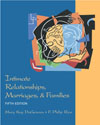 |  Intimate Relationships, Marriages, and Families, 5/e Mary K. DeGenova
Philip F. Rice
Mate Selection, Nonmarital Cohabitation, and Transition to Marriage
Chapter ObjectivesAfter reading the chapter, you should be able to:
1.discuss nonmarital cohabitation in each of the following areas:- patterns of relationships
- effect on marriage
- effect on children
|
 |  |  | 2.understand the psychodynamic theories of mate selection: parent image theory and ideal mate theory. |
 |  |  | 3.describe the traditional exchange theory of mate selection and equity theory. |
 |  |  | 4.explain the components of the developmental process theory of mate selection: |
 |  |  | 5.describe how family background factors are related to mate selection |
 |  |  | 6.explain the concept of the marriage gradient. |
 |  |  | 7.describe how personal characteristics influence mate selection |
 |  |  | 8.explain why some people regret their choice of a mate. |
 |  |  | 9.understand the importance of each of the following factors in marital readiness:- age and maturity
- timing of marriage
- motives for marriage
- readiness for sexual exclusiveness
- emotional emancipation from parents
- education and vocational readiness
|
 |  |  | 10.discuss marriage as a civil contract and summarize the major legal state requirements regulating marriage. |
 |  |  | 11.discuss the need to prepare for marriage and the roles of education, premarital assessment, and counseling. |
 |  |  | 12.describe the following rites of passage and their functions:- engagement
- the wedding as a religious and civil rite
|
|



 2002 McGraw-Hill Higher Education
2002 McGraw-Hill Higher Education